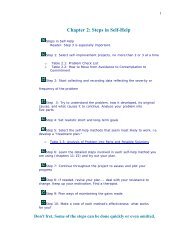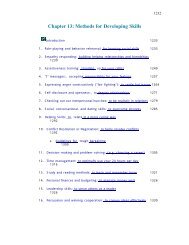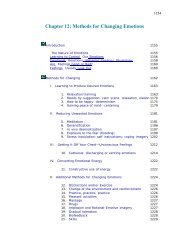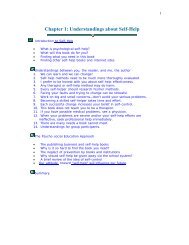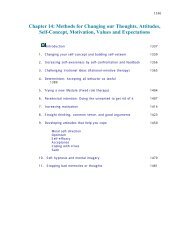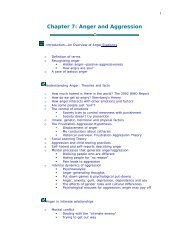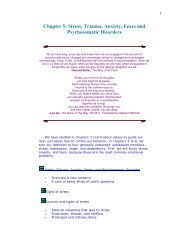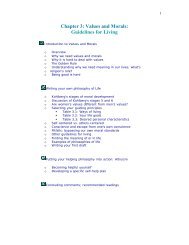Methods for Changing Behaviors - Psychological Self-Help
Methods for Changing Behaviors - Psychological Self-Help
Methods for Changing Behaviors - Psychological Self-Help
You also want an ePaper? Increase the reach of your titles
YUMPU automatically turns print PDFs into web optimized ePapers that Google loves.
thoughts or feelings (self-criticism, stress, dependency). Be clear in<br />
your mind what you want to avoid.<br />
As in method #16, you should also have a specific desired behavior<br />
in mind if you want to use negative rein<strong>for</strong>cement to strengthen it.<br />
Remember rein<strong>for</strong>cement (negative or positive) primarily strengthens<br />
immediately preceding responses.<br />
STEP TWO: Identify existing unwanted behaviors that may be<br />
maintained by negative rein<strong>for</strong>cement; plan a better way to<br />
handle the situation.<br />
You may not need this step. But if you have a fear rein<strong>for</strong>ced by<br />
avoiding something, anger strengthened by getting your way, passivity<br />
based on avoiding confrontations, self-putdowns that reduce the<br />
criticism of others, procrastination that avoids stress and immediate<br />
challenges but neglects the future, etc., then you need to recognize<br />
what is going on. Usually these unwanted behaviors are effective in<br />
reducing the immediate stress but destructive in terms of your longrange<br />
life goals.<br />
You need to achieve the immediate relief with new, healthier<br />
behaviors that will also facilitate your life goals. This new behavior will<br />
have to be learned, rein<strong>for</strong>ced, practiced, and perfected. Examples:<br />
Learn to face a fear rather than avoid it, learn to be assertive instead<br />
of aggressive or passive, learn to be self-accepting in spite of criticism,<br />
learn to be organized and prompt instead of putting things off, etc.<br />
(See 3 in the next step).<br />
STEP THREE: Arrange <strong>for</strong> the desired behavior to reduce some<br />
unpleasant experience.<br />
All of these self-help methods involve getting away from an actual<br />
or potentially unpleasant situation. In some methods you create the<br />
unpleasantness yourself, in others the unpleasantness exists without<br />
ef<strong>for</strong>t on your part. Here are some examples:<br />
1. Learn how to tactfully and effectively avoid or escape<br />
something unpleasant (see method #1 and chapter 8).<br />
Examples: Suppose you have a very talkative friend, try simply<br />
saying, "I really must go." The relief rein<strong>for</strong>ces your<br />
assertiveness. Like a defensive driver, you can anticipate<br />
conversational pitfalls and avoid topics that lead to fruitless<br />
heated arguments or embarrassment. (Of course, carried to an<br />
extreme you may become a wimp...or a statesperson.)<br />
2. Set up on-going unpleasant conditions which you can escape by<br />
doing the desired behavior. Examples: A dieter or smoker or<br />
procrastinator can become self-demanding and repeatedly<br />
recite to yourself the disadvantages of the bad habit, then<br />
escape the self-criticism by being "good." Someone else could<br />
nag you (at your request).<br />
1138



